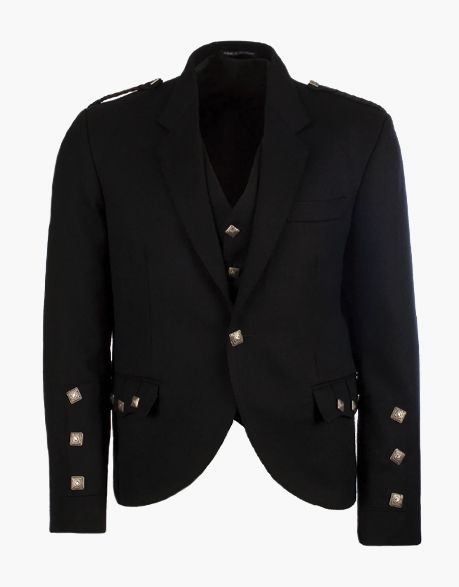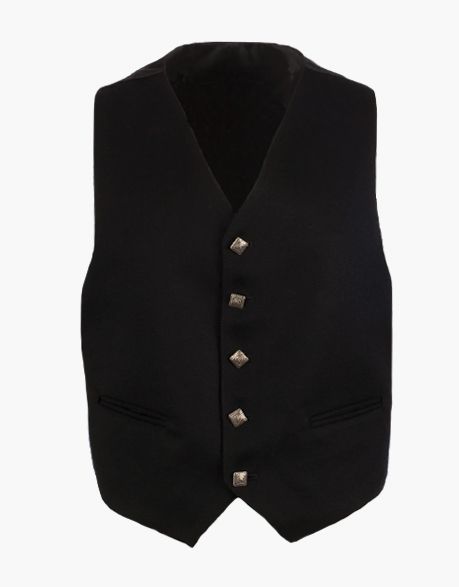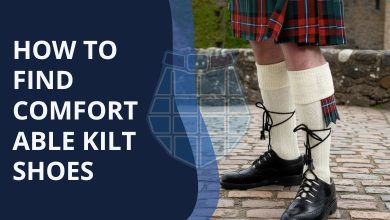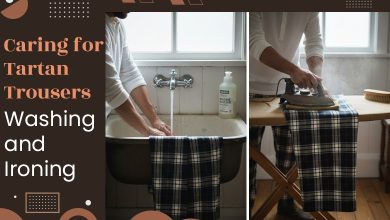Caring and Storing Your Kilt Jacket and Waistcoat
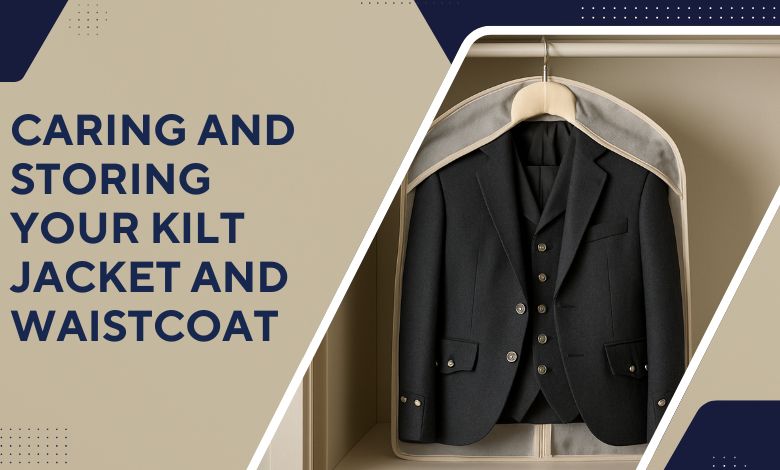
You must have seen Scots wearing special jackets and waistcoats at formal events. They are essential components of traditional Scottish Highland dress. Besides being traditional parts of the attire, they help you attain a modern look. For a polished look, both of these parts should be neat and clean, which is only possible with proper maintenance. Other than enhanced appearance, they help your attire to last for years. All you need is proper cleaning and maintenance of your garments. If you are new to this domain, this guide will be quite helpful for you to protect your investment while preserving the rich style of Scottish tradition. So, ensure an understanding of the best practices as they guarantee your attire parts will remain in excellent condition.
Table of Contents
ToggleUnderstanding Kilt Material
Both garments are typically made from premium wool, tweed, or Barathea. These fabrics are long-lasting and add to the appearance of wearers. Barathea wool is a smooth, tightly woven cloth, which is a top priority because of its lovely stature. Other embellishments such as decorative metal or horn buttons or satin linings are common to spot-on clothing items. These components are often made from different materials, primarily with metal and require different cleaning methods than fabric.
Cleaning Your Kilt Jacket and Waistcoat
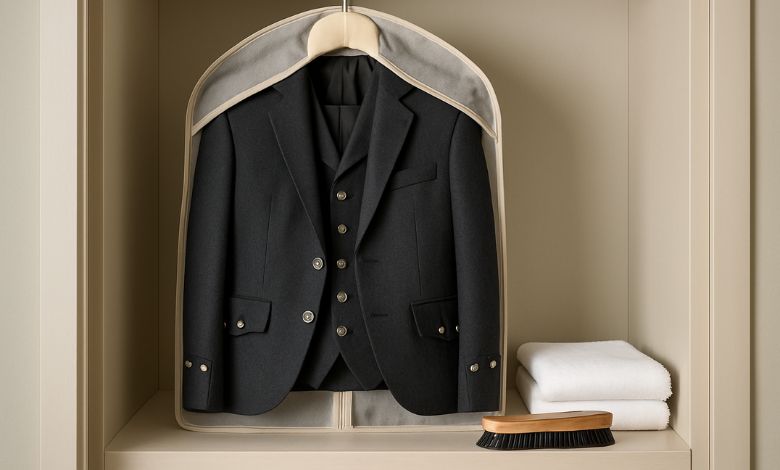
A waistcoat and kilt jacket are pretty different from other clothing and so are their cleaning requirements. As they enhance your formal appearance and represent your Scottish ancestry, following every expert tip will help you completely clean them. That’s why you should pay close attention to preserving their durability and beauty. To maintain their quality, this handbook describes the recommended techniques.
General Maintenance
General maintenance is the first and most important point to understand. You should use a soft clothes brush to remove the dust on the outer surface and keep your clothing fresh. Regarding shape maintenance, always hang them on cushioned hangers. The next thing is to prevent them from mold, moth damage, and moisture accumulation. To do so, ensure keeping them in cool, dry locations in breathable clothing bags.
Dry Cleaning: Do not wash your jacket but prioritize dry cleaning. Take it to the cleaners who are experienced with delicate textiles such as wool and tweed kilt jackets and waistcoats. Only dry clean if you find it filthy while experts recommend it once or twice a year. Make sure to read the care label before you bring them to cleaners. Do not hesitate to consult professionals if you find any new instructions or you have some specific requirements.
Dealing with Stains: Jackets are usually available in dark shades and stains become more prominent on them. So you must remove it as a priority using a fresh, dry towel by gently wiping it to the impacted part. Avoid rubbing the fabric as it damages the texture and the dye of fabric.
Ironing, Steaming, and Wrinkle Removal
Improper storage can result in wrinkles and diminishing the value or appearance of your jacket. So, you should not overrate proper storage to maintain a crisp, elegant look. It is a suggestion to handle wrinkles carefully. Doing it does not require much knowledge but a little effort.
- Avoid direct ironing, as excessive heat can damage wool or tweed fabric.
- It is better to use a steamer to gently release wrinkles.
- Holding it a few inches away from the fabric.
- If they are necessary to iron, place a pressing cloth between the iron and the garment to lower heat intensity.
- The last step is to hang the garments immediately to prevent creasing. Store them properly to maintain their shape.
Storing Your Kilt Jacket and Waistcoat
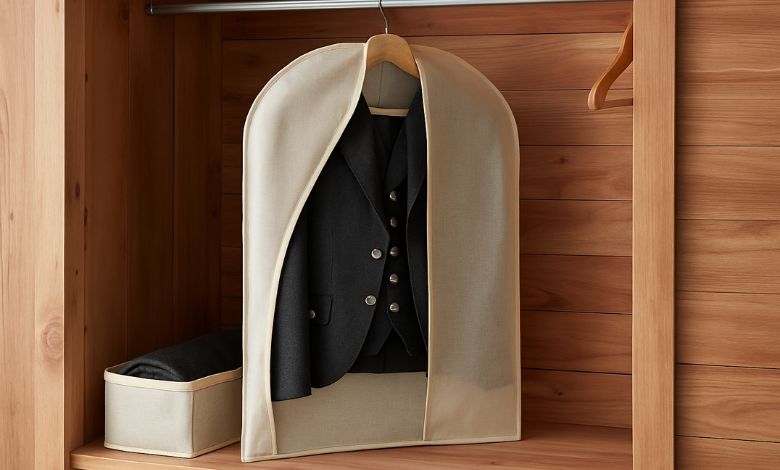
The negative effects of improper storage should be clear. Therefore, proper storage is the best way to avoid wrinkles in a jacket and waistcoat. Usually, there are two types of storage: short-term and long-term. So, you should deal carefully according to the time to store them.
Short-Term Storage: The short-term storage of the jacket and waistcoat involves a few steps. First of all, ensure they are already clean and free of dust. Hang these garments to a suitable hanger covering them in fabric beige. Moreover, confirm that the place is cool, dry, and highly breathable.
Long-Term Storage: If you have to store them for longer durations. The process may be as simple as for short-term storage. When storing for an extended period, dry clean them from experts. Provide your garment a considerable space to breathe, and prevent sagging, and potential creasing. Furthermore, roll the jacket rather than folding it because rolling minimizes creasing, especially in the pleats.
Seasonal Care Tips
Summer Caring Tips
| Jacket Care Tips | Waistcoat Care Tips |
| Air out after use to remove sweat and prevent odor. | Clean small spots with a damp cloth if needed. |
| Store away from UV exposure to prevent fabric fading. | Try not to wear the same one every day—rotate if you can. |
| Dry cleaning, only when necessary to avoid wear on wool. | Don’t wear too many layers under it to avoid sweating too much. |
| Use breathable garment bags; avoid plastic. | Hang it up flat to keep its shape. |
| Use cedar hangers as they Help prevent moths and keep shape. |
Winter Caring Tips
| Kilt Jackets | Waistcoats |
| Brush off dust or salt often, especially after being outside. | Choose one with a lining or wear something warm underneath |
| Use a steamer on low settings to remove wrinkles and freshen it up. | Take it off indoors if it gets too warm to avoid sweating. |
| If it gets wet, hang it up to dry naturally. | Watch for little fabric balls or loose threads and fix them early. |
| Wear layers underneath to stay warm and keep the jacket cleaner. | Store in a dry place, and use lavender or cedar to keep moths away. |
Packing and Traveling with Your Kilt Jacket
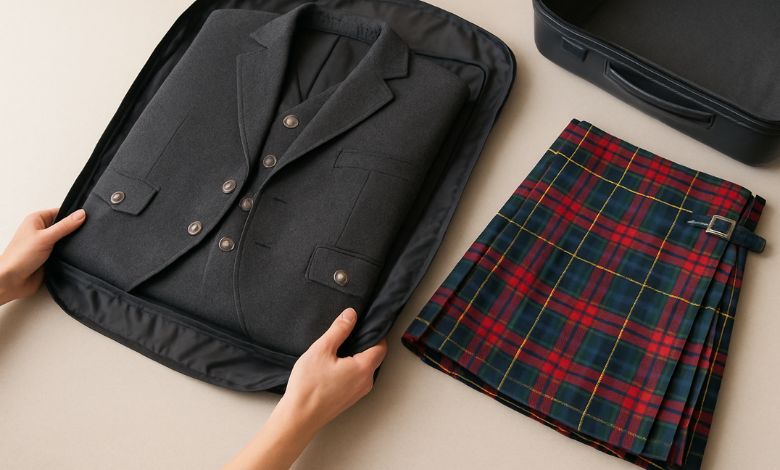
Proper storage also proves to be suitables when you have to travel and store a kilt jacket in your bag. The process is a bit tricky and requires your attention. Here are some exceptional tips:
- When packing your jacket, lay it flat on a clean, plain surface in a way that buttons should face up.
- Create a rectangle by folding each side of the jacket toward the center.
- Slide the folded jacket into a garment bag, preferably a kilt-specific one, to protect it from wrinkles and other items in your suitcase.
- Place the garment bag in your suitcase, ensuring it’s not crushed or compressed by other items.
Kilts Jackets & Waistcoats to Buy
Many jackets are worn with kilts today but the most common ones among them are Prince Charlie Jacket, tweed jackets, and Argyll jackets.
Utility Kilt UK: Your Ideal Store for Kilt Jackets and Waistcoats
Whenever you buy a set of kilt jackets and a waistcoat, ensure to go with premium-quality fabric as it does not easily get wrinkles. Similarly, the maintenance requirements are also lower. You may ask us where to buy such products. We strongly recommend Utility Kilt UK because of its reliable services, premium quality, affordability, expert customization, and secure payment methods. So, visit our online store today and order exceptional products including men’s kilts.
FAQs About Kilt Jacket Care
What’s the best way to remove odors from a kilt jacket without washing?
Markets are full of odor absorbers. You can buy one according to your jacket’s fabric and spray it. Therefore, the natural way is to air dry whenever you wear it.
How do I store my kilt jacket if I don’t have a garment bag?
It is better to buy a bag if you have to store a jacket for a longer duration. You can neatly fold it and place it in the wardrobe in a way that no other fabric presses it. Doing so will not cause wrinkles to the jackets in a day or two.
How often should moth repellents be replaced during long-term storage?
When it comes to using moth repellent, the quality of your jacket’s fabric plays the most important role. Therefore, experts suggest using repellant thrice or four times a year. If a toxic, yet safe repellent is available, it may last for six months.
Can I apply waterproof sprays to kilt jackets for added protection?
It’s a good idea to apply waterproof spray to the jacket for additional safety as it secures fabric. First, make sure that the spray is suitable for the fabric. Apply it to any hidden, yet smaller part of the jacket. If it works, you can use this spray confidently.


